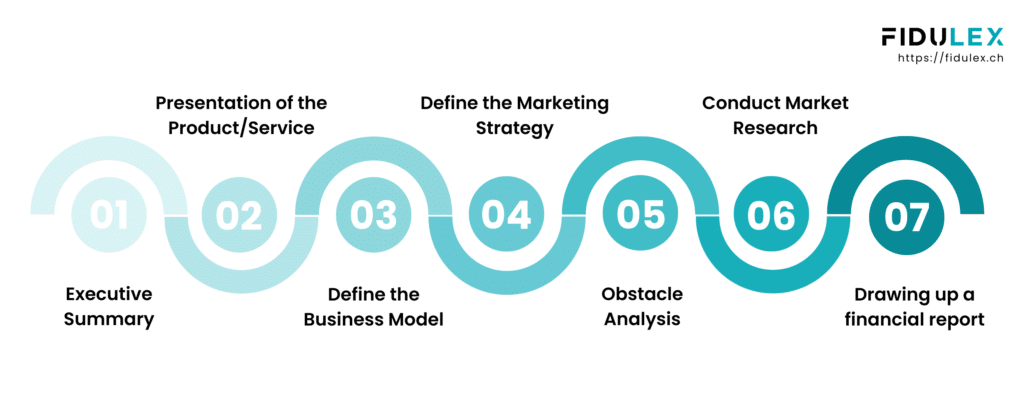
Creating a business plan from A to Z
If you have a business idea you'd like to realize, it's essential to make a business plan.
This document must detail your company projectThe purpose of this document is to determine the viability of your project internally, or to convince potential investors. In this article, we will review the essential elements to include in this document.
Definition and purpose of a business plan
A business plan is an essential document for setting up a company, because it summarizes your project and the stages of its development, from the defining of the field of activity to the project's financing.
The purpose of the business plan is to verify the feasibility of your project, or to convince your investors of its seriousness. You'll need to show that you've done your research into the environment in which you'll be operating, through a market analysis for example.
You need to be able to show your project in a favourable light while remaining realistic.
Important information:
Like a cover letter is tailored to each employer, you'll need to create different versions of your business plan depending on the investor you're talking to.
Adapting your business plan
In addition, you will need to present your project differently depending on whether you are talking to :
- A banker, where you need to demonstrate your ability to repay a loan
- A business angel*, where you emphasize the innovative nature of your company
- A public investor where you need to show how your project can benefit society
*One Business angel is an individual who helps a company to grow, because he or she sees great potential.
Executive summary (presentation pitch)
Your pitch is a quick summary It should be able to convince your investor in just a few minutes.
You'll also need to adapt it to the person you're talking to, who can't always be the same. You'll need to demonstrate quickly that you have the qualities needed to run a company, and that you've prepared long and hard.
You'll also need to demonstrate your ability to work as part of a team if you have partners. Here are a few ideas to get you started pitch writing :
- Presentation
Introduce yourself and your potential partners
- Your project
Present your project, your motivations, its history, the legal form you wish to choose, what productors and/or services you'll provide, etc.
- The risks
Identify potential risks as well as your competitors
- The market
Define the market you want to target (including the consumer habits of said target market)
- Your progress
Show that you have prepared both the present and the future of your company, i.e. your concrete plans for the future development of your project.
You should also draw on your research, such as your market study and any experience you may have, to prepare your pitch.
Present the product or service
This is an essential step, as you'll be describing your company's offering in detail, showing what makes you unique. from the rest companies offering similar products or services.
For describe your product and/or service, you can present :
- Its features
- Its cost
- Its production
- Its sales process
- The customer service you'll offer
It is important to use a plain language and avoid jargon. Imagine you're talking to someone who has no knowledge of your sector.
To do this, it can be useful to present your service using images and infographics.
Defining your business model
Your business model is the strategy your company intends to use to make a profit.
You'll need to estimate the costs you'll incur, the products and services you wish to offer, and your target clientele.
A business model is bound to change as your company develops and evolves, so be sure to keep the future of your company in mind.
A company like Netflix, for example, would never have survived the arrival of the Internet and the disappearance of CDs and video cassettes if it hadn't changed its business model. The company went from distributing physical copies to enabling customers to view their favorite content at home, on a streaming platform.
There are several types of models to choose from:
Business 2 Business Model (B2B)
B2B is a business model where transactions take place between companies, rather than between a company and a private customer.
This often involves larger transactions, such as wholesaling. In this case, the wholesaler buys a large quantity of stock or raw materials from a manufacturer and/or supplier. He then resells this stock to other companies (retailers, resellers, etc.). The reseller is then the direct link to the private customer.
For example, if you're a company that buys jewelry wholesale from a supplier in order to resell it in your store, you're using a B2B model.
This market offers greater stability and is much more predictable, since purchases are often made in bulk, which significantly reduces costs for the company.
Business 2 Consumer Model (B2C)
Companies following this model sell directly to a private customer, who is the end-user of the products purchased.
If we take the previous example, the jewelry retailer who sells jewelry in his boutique to private customers is following the B2C model.
The B2C model is most often used to refer to online platforms that direct customers to the products they are looking for.
Amazon, for example, also follows this model, as the company connects customers with products they are looking for, through their online platform.
An even simpler example is a supermarket, which sells its products directly to the consumer.
Subscription-based model
This business model makes it possible to sell a product or service and earn a profit. recurring revenues to continue providing this service or product.
As a result, these companies focus on customer loyalty rather than the acquisition of new customers.
This model is becoming increasingly popular, enabling customers to pay a smaller sum over a longer term rather than spending a lot of money at once.
Although this model is advantageous for both the customer and the company, depending on the product, it can give the buyer the impression that they will never actually own the product they are paying for. Another thing to bear in mind is that, due to the sheer number of companies operating on this model, it can create some frustration for the customer.
An example of this model would be the Netflix platform. Every month, customers pay a certain amount of money to continue viewing content. This helps the company produce more content and maintain its platform.
On-demand model
This model consists of giving customers what they want as quickly as possible, i.e. puts you in touch the customer with a company that can provide the requested service.
Some apps, for example, can connect patients with doctors, making it easier to book appointments.
Other companies like Uber connect people looking for fast transportation with drivers.
Defining your marketing strategy
It will be imperative to make the strategy presentation that you will use to sell your product and/or service.
Among other things, you'll need to establish the price of your product or service. Other aspects to consider are :
- Production (where, how and by whom your product will be made)
- Possible storage location
- Product/service distribution
- Place of sale (online or in a physical location)
- Advertising to promote your product and your company
- How you're going to build customer loyalty (with a subscription formula, for example)
Keep your company's future in mind, too, by outlining how you intend to develop your business.
For example, if you start with a physical store, will you eventually move on to an online store and vice versa? Or are you planning to expand internationally?
Analysis of potential obstacles
As the title suggests, you'll need to identify and plan for potential constraints of your activity, i.e. what could slow you down.
You'll need to show, for example, that you know your competitors, but also that you took into account the costs of all the different aspects mentioned in the previous section, such as the cost of production, storage, distribution and communication, and whether these costs are fixed or fluctuating.
So not only do you have to consider these factors, you also have to show how you can overcome them.
Conducting market research
Including a market study will make all the difference as it will allow you to identify your future clientele, such as :
- Who is she?
- What are their consumption habits?
- What price are they willing to pay for what you offer?
Analyzing current supply and demand will also be essential for the establishment of your business in general.
Ask yourself what your particular product will offer and why a potential customer should choose yours over another.
Drawing up a financial report
To find investors, you'll need to prove that your business project is feasible and, above all, that it will be profitable.
To do this, calculate all the expenses that will be necessary for the smooth running of your business, such as :
- Expenses (employee salaries, taxes, etc.)
- Financial requirements to start your business
You'll also need to include an estimate of your sales, taking into account any changes in the market.
All these predictions must be based on the next 3 years.
Conclusion
As you've seen throughout this article, writing a business plan requires a great deal of research and preparation. You'll need to prove that you're very familiar with your subject, while presenting it clearly and concisely.
Frequently Asked Questions
Who can draw up a business plan for me?
It's perfectly possible to do it alone.
There are many online resources who can provide you with examples of this document.
But you can also choose to call in a chartered accountant, or a specialist firm.
What's the point of drawing up a business plan?
This document is useful for you and your investors. It gives your project a concrete structure.
This will give you an idea of the feasibility of your idea.
What is a business model?
This is the strategy your company intends to implement to make a profit.
There are several types, including B2B, B2C, subscription-based and on-demand.
What's the point of market research?
This allows you to get to know your future customers, their habits, and the profit you can make by knowing all these elements.
Can you help me set up my company in Switzerland?
Of course you can. Our trustee can help you set up a company in Switzerland or obtain self-employed status.







